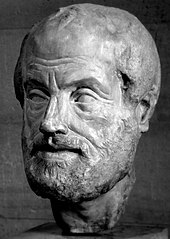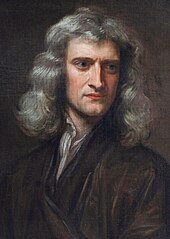
A | B | C | D | E | F | G | H | CH | I | J | K | L | M | N | O | P | Q | R | S | T | U | V | W | X | Y | Z | 0 | 1 | 2 | 3 | 4 | 5 | 6 | 7 | 8 | 9
| Force | |
|---|---|
 | |
Common symbols | , F, F |
| SI unit | newton (N) |
Other units | dyne, pound-force, poundal, kip, kilopond |
| In SI base units | kg·m·s−2 |
Derivations from other quantities | F = ma |
| Dimension | |
| Part of a series on |
| Classical mechanics |
|---|
In physics, a force is an influence that can cause an object to change its velocity, i.e., to accelerate, meaning a change in speed or direction, unless counterbalanced by other forces. The concept of force makes the everyday notion of pushing or pulling mathematically precise. Because the magnitude and direction of a force are both important, force is a vector quantity. The SI unit of force is the newton (N), and force is often represented by the symbol F.[1]
Force plays a central role in classical mechanics, figuring in all three of Newton's laws of motion, which specify that the force on an object with an unchanging mass is equal to the product of the object's mass and the acceleration that it undergoes. Types of forces often encountered in classical mechanics include elastic, frictional, contact or "normal" forces, and gravitational. The rotational version of force is torque, which produces changes in the rotational speed of an object. In an extended body, each part often applies forces on the adjacent parts; the distribution of such forces through the body is the internal mechanical stress. In equilibrium these stresses cause no acceleration of the body as the forces balance one another. If these are not in equilibrium they can cause deformation of solid materials, or flow in fluids.
In modern physics, which includes relativity and quantum mechanics, the laws governing motion are revised to rely on fundamental interactions as the ultimate origin of force. However, the understanding of force provided by classical mechanics is useful for practical purposes.[2]
Development of the concept
Philosophers in antiquity used the concept of force in the study of stationary and moving objects and simple machines, but thinkers such as Aristotle and Archimedes retained fundamental errors in understanding force. In part, this was due to an incomplete understanding of the sometimes non-obvious force of friction and a consequently inadequate view of the nature of natural motion.[3] A fundamental error was the belief that a force is required to maintain motion, even at a constant velocity. Most of the previous misunderstandings about motion and force were eventually corrected by Galileo Galilei and Sir Isaac Newton. With his mathematical insight, Newton formulated laws of motion that were not improved for over two hundred years.[1]
By the early 20th century, Einstein developed a theory of relativity that correctly predicted the action of forces on objects with increasing momenta near the speed of light and also provided insight into the forces produced by gravitation and inertia. With modern insights into quantum mechanics and technology that can accelerate particles close to the speed of light, particle physics has devised a Standard Model to describe forces between particles smaller than atoms. The Standard Model predicts that exchanged particles called gauge bosons are the fundamental means by which forces are emitted and absorbed. Only four main interactions are known: in order of decreasing strength, they are: strong, electromagnetic, weak, and gravitational.[4]: 2–10 [5]: 79 High-energy particle physics observations made during the 1970s and 1980s confirmed that the weak and electromagnetic forces are expressions of a more fundamental electroweak interaction.[6]
Pre-Newtonian concepts

Since antiquity the concept of force has been recognized as integral to the functioning of each of the simple machines. The mechanical advantage given by a simple machine allowed for less force to be used in exchange for that force acting over a greater distance for the same amount of work. Analysis of the characteristics of forces ultimately culminated in the work of Archimedes who was especially famous for formulating a treatment of buoyant forces inherent in fluids.[3]
Aristotle provided a philosophical discussion of the concept of a force as an integral part of Aristotelian cosmology. In Aristotle's view, the terrestrial sphere contained four elements that come to rest at different "natural places" therein. Aristotle believed that motionless objects on Earth, those composed mostly of the elements earth and water, were in their natural place when on the ground, and that they stay that way if left alone. He distinguished between the innate tendency of objects to find their "natural place" (e.g., for heavy bodies to fall), which led to "natural motion", and unnatural or forced motion, which required continued application of a force.[7] This theory, based on the everyday experience of how objects move, such as the constant application of a force needed to keep a cart moving, had conceptual trouble accounting for the behavior of projectiles, such as the flight of arrows. An archer causes the arrow to move at the start of the flight, and it then sails through the air even though no discernible efficient cause acts upon it. Aristotle was aware of this problem and proposed that the air displaced through the projectile's path carries the projectile to its target. This explanation requires a continuous medium such as air to sustain the motion.[8]
Though Aristotelian physics was criticized as early as the 6th century,[9][10] its shortcomings would not be corrected until the 17th century work of Galileo Galilei, who was influenced by the late medieval idea that objects in forced motion carried an innate force of impetus. Galileo constructed an experiment in which stones and cannonballs were both rolled down an incline to disprove the Aristotelian theory of motion. He showed that the bodies were accelerated by gravity to an extent that was independent of their mass and argued that objects retain their velocity unless acted on by a force, for example friction.[11] Galileo's idea that force is needed to change motion rather than to sustain it, further improved upon by Isaac Beeckman, René Descartes, and Pierre Gassendi, became a key principle of Newtonian physics.[12]
In the early 17th century, before Newton's Principia, the term "force" (Latin: vis) was applied to many physical and non-physical phenomena, e.g., for an acceleration of a point. The product of a point mass and the square of its velocity was named vis viva (live force) by Leibniz. The modern concept of force corresponds to Newton's vis motrix (accelerating force).[13]
Newtonian mechanics
Sir Isaac Newton described the motion of all objects using the concepts of inertia and force. In 1687, Newton published his magnum opus, Philosophiæ Naturalis Principia Mathematica.[1][14] In this work Newton set out three laws of motion that have dominated the way forces are described in physics to this day.[14] The precise ways in which Newton's laws are expressed have evolved in step with new mathematical approaches.[15]
First law
Newton's first law of motion states that the natural behavior of an object at rest is to continue being at rest, and the natural behavior of an object moving at constant speed in a straight line is to continue moving at that constant speed along that straight line.[14] The latter follows from the former because of the principle that the laws of physics are the same for all inertial observers, i.e., all observers who do not feel themselves to be in motion. An observer moving in tandem with an object will see it as being at rest. So, its natural behavior will be to remain at rest with respect to that observer, which means that an observer who sees it moving at constant speed in a straight line will see it continuing to do so.[16]: 1–7

Second law
According to the first law, motion at constant speed in a straight line does not need a cause. It is change in motion that requires a cause, and Newton's second law gives the quantitative relationship between force and change of motion. Newton's second law states that the net force acting upon an object is equal to the rate at which its momentum changes with time. If the mass of the object is constant, this law implies that the acceleration of an object is directly proportional to the net force acting on the object, is in the direction of the net force, and is inversely proportional to the mass of the object.[17]: 204–207
A modern statement of Newton's second law is a vector equation: where is the momentum of the system, and is the net (vector sum) force.[17]: 399 If a body is in equilibrium, there is zero net force by definition (balanced forces may be present nevertheless). In contrast, the second law states that if there is an unbalanced force acting on an object it will result in the object's momentum changing over time.[14]
In common engineering applications the mass in a system remains constant allowing as simple algebraic form for the second law. By the definition of momentum, where m is the mass and
Antropológia
Aplikované vedy
Bibliometria
Dejiny vedy
Encyklopédie
Filozofia vedy
Forenzné vedy
Humanitné vedy
Knižničná veda
Kryogenika
Kryptológia
Kulturológia
Literárna veda
Medzidisciplinárne oblasti
Metódy kvantitatívnej analýzy
Metavedy
Metodika
Text je dostupný za podmienok Creative
Commons Attribution/Share-Alike License 3.0 Unported; prípadne za ďalších
podmienok.
Podrobnejšie informácie nájdete na stránke Podmienky
použitia.
www.astronomia.sk | www.biologia.sk | www.botanika.sk | www.dejiny.sk | www.economy.sk | www.elektrotechnika.sk | www.estetika.sk | www.farmakologia.sk | www.filozofia.sk | Fyzika | www.futurologia.sk | www.genetika.sk | www.chemia.sk | www.lingvistika.sk | www.politologia.sk | www.psychologia.sk | www.sexuologia.sk | www.sociologia.sk | www.veda.sk I www.zoologia.sk







